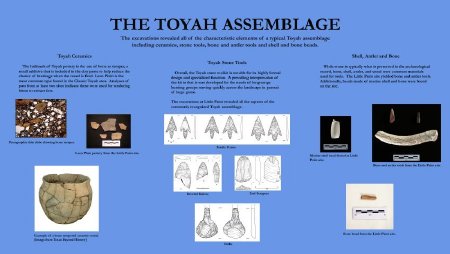Title:
Panel 5: The Toyah Assemblage
Collection:
Little Paint Collection
Object ID:
CAS.2013.07.PIC.86
VE Exhibit Label 1:
THE TOYAH ASSEMBLAGE
The excavations revealed all of the characteristic elements of a typical Toyah assemblage including ceramics, stone tools, bone and antler tools, and shell and bone beads.
The excavations revealed all of the characteristic elements of a typical Toyah assemblage including ceramics, stone tools, bone and antler tools, and shell and bone beads.
VE Exhibit Label 2:
Toyah Ceramics
The hallmark of Toyah pottery is the use of bone as temper, a small additive that is included in the clay paste to help reduce the chance of breakage when the vessel is fired. Leon Plain is the most common type found in the Classic Toyah area. Analyses of pots from at least two sites indicate these were used for rendering bison to extract fats.
The hallmark of Toyah pottery is the use of bone as temper, a small additive that is included in the clay paste to help reduce the chance of breakage when the vessel is fired. Leon Plain is the most common type found in the Classic Toyah area. Analyses of pots from at least two sites indicate these were used for rendering bison to extract fats.
VE Exhibit Label 3:
Toyah Stone Tools
Overall, the Toyah stone toolkit is notable for its highly formal design and specialized function. A prevailing interpretation of the kit that it was developed for the needs of long—range hunting groups moving quickly across the lndscape in pursuit of large game.
The excavations at Little Paint revealed all the aspects of the commonly recognized Toyal assemblage.
Overall, the Toyah stone toolkit is notable for its highly formal design and specialized function. A prevailing interpretation of the kit that it was developed for the needs of long—range hunting groups moving quickly across the lndscape in pursuit of large game.
The excavations at Little Paint revealed all the aspects of the commonly recognized Toyal assemblage.
VE Exhibit Label 4:
Shell, Antler, and Bone
While stone is typically what is preserved in the archaeological record, bone, shell, antler, and wood were common materials used for tools. The Little Paint site yielded bone and antler tools. Additionally, beads made of marine shells and bone were found on the site.
While stone is typically what is preserved in the archaeological record, bone, shell, antler, and wood were common materials used for tools. The Little Paint site yielded bone and antler tools. Additionally, beads made of marine shells and bone were found on the site.
